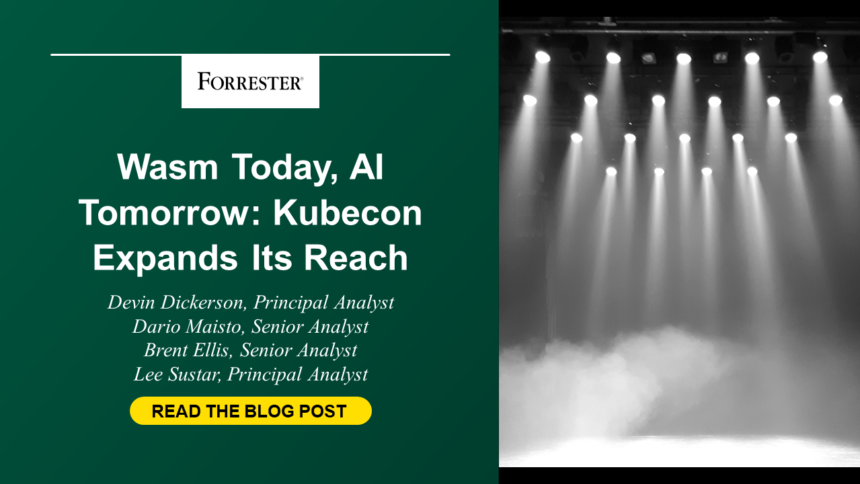KubeCon is the place where big tech and large enterprise cloud users converge with open-source communities and startups to collaborate on the latest trends in cloud-native. Generally, Kubernetes (K8s) has become the epicenter of platform engineering innovation, and that trend continued this year. The biggest waves at KubeCon Europe for 2024: platform innovations across generative AI (genAI), WebAssembly (Wasm), and cloud sustainability. Here’s what you need to know.
The K8s Ecosystem Is Asserting Its Place In An AI-Centric World
Like most conferences over the past year or so, KubeCon Europe put AI on center stage; more notably, it didn’t disappoint. The Kubernetes ecosystem has been systematically enhancing the previous generation of K8s-based AI/ML capabilities. Simply put, K8s was not designed with LLMs in mind, but it does have some inherent advantages: flexibility and scalability (even beyond cloud-based VM scalability), and with many ecosystems. NVIDIA’s Kevin Klues and Sanjay Chatterjee highlighted this idea in their day two keynote on accelerating AI workloads with Kubernetes — but made it clear that more work is needed. “We still have a lot of work to do before we can unlock the full potential of GPUs to accelerate AI workloads on Kubernetes,” Klues said. “This includes changes to both the low-level mechanisms used to request access to GPUs as well as the higher-level processes needed to map a set of GPUs to a workload.” Will this be enough to take focus away from cloud provider AI-managed services? Time will tell.
Wasm Hits The Keynote Stage And The Data Center
Much of the Wasm excitement of 2023 carried over into KubeCon Europe 2024 but with a noticeable difference: SpinKube. Fermyon submitted SpinKube as an open-source project into the CNCF sandbox, which marks a major milestone for Wasm enthusiasts and cloud-native platform engineering. Across the cloud-native ecosystem, we have seen an uptick in Wasm’s ubiquity over the past year, particularly under the hood of development platforms as a portable compilation and deployment target. This year, KubeCon demonstrated Wasm as a first-class workload on K8s platforms, with real-world stories such as how ZEISS Group leveraged Wasm to improve workload density and cut compute costs for Kubernetes-based batch processing use cases. As the server-side Wasm enabler, WASI, becomes standardized, back-end use of Wasm like in the ZEISS case study will become more common. With that said, it is an important reminder that Wasm won’t replace K8s; it will add to its appeal as a platform of platforms.
Cloud Sustainability Enters The KubeCon Agenda
Kubernetes is serving the sustainable cloud agenda as environmental sustainability becomes increasingly relevant to EU firms. For instance, while VMs take minutes to start and containers seconds, Wasm takes only milliseconds — each can reduce system utilization but with Wasm taking the limelight. Among other benefits it brings, Wasm is compact and fast: An uncompressed JavaScript file can be 100 times larger than an equivalent WebAssembly file — hence, smaller WebAssembly apps download faster, which reduces the time for a web page to become interactive. Further, compiled WebAssembly code runs much faster than dynamically loaded JavaScript files, improving efficiency and reducing overall resource consumption.
Organizations are building dashboards to help track the sustainability strides made with K8s and Wasm via green observability dashboards. For example, Deutsche Bahn was on the keynote stage to show how it’s using Grafana for: 1) out-of-the-box dashboards, metrics, alerts, and logs for Kubernetes and legacy infrastructure; 2) single agent setup for collecting metrics, logs, and traces; and 3) discovering underutilized resources within Kubernetes clusters. In the same keynote, Shopify illustrated how sustainability has become a shared responsibility of the cloud provider and the end user.
What Should You Do Next?
- Revamp your cloud strategy with AI in mind. Your business peers want answers as to how your organization is going to take advantage of genAI (or AI, more broadly speaking). Cloud technologies are some of the leading contenders to power these initiatives. You will likely need to weigh your options by initiative between a la carte options from the cloud-native ecosystem with more packaged out-of-the-box managed AI services from the public cloud. Few in your organization will have this level of expertise to help inform these decisions, so get ready to help advise.
- Assess Wasm-enabled developer platforms. For enterprises looking to benefit from innovations in Wasm, the best place to start is in developer platforms and tools already leveraging the technology. Companies such as Cosmonic, Fastly, and Fermyon bake Wasm into their platforms already, and our research shows that edge development is emerging as a key proving ground for Wasm.
- Leverage Kubernetes for your cloud sustainability initiatives. Kubernetes has evolved to be much more than a container orchestration platform. Containerization and Wasm can contribute to make your cloud deployments more efficient and sustainable. Whether you are new to Kubernetes or you have leveraged the technology since its inception, start considering it as also a way to reach your CO2 emissions reduction goals. This will not make for — and will not substitute — more impacting and widespread initiatives such as replacing stone-age data centers but does give its contribution in environmental terms while improving efficiency.
Reach out to Forrester to schedule an inquiry to help guide your cloud-native initiatives or to dig into these announcements.







